
ESSAYS
"What Would Bob Do?"
By Michael Barrier
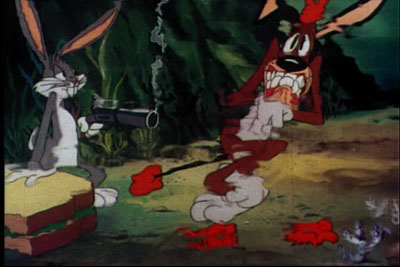 In February 2008, in one of a series of posts centered on Bob Clampett's Buckaroo Bugs (1944), I suggested that one source of disagreement about the merits of that cartoon, as well as some other Clampetts, like Hare Ribbin' (1944, illustrated at the right) was an emphasis by the director's admirers "on details of direction and animation, at the expense of any serious examination of the films as a whole. In a number of cases, I think, it's much easier to praise a Clampett cartoon on the basis of those details than of the impression left by the entire film."
In February 2008, in one of a series of posts centered on Bob Clampett's Buckaroo Bugs (1944), I suggested that one source of disagreement about the merits of that cartoon, as well as some other Clampetts, like Hare Ribbin' (1944, illustrated at the right) was an emphasis by the director's admirers "on details of direction and animation, at the expense of any serious examination of the films as a whole. In a number of cases, I think, it's much easier to praise a Clampett cartoon on the basis of those details than of the impression left by the entire film."
The Buckaroo Bugs discussion concerned mostly how Clampett presented Bugs Bunny himself—as a sort of mischievous teen (the pro view) or a sneering bully (my negative view). I didn't explain why I thought "the impression left by the entire film" might have been unsatisfactory even if Bugs Bunny was absent, but I had in mind what I described, in Hollywood Cartoons: American Animation in Its Golden Age, as a conflict between the styles of the two most important animators of the Clampett cartoons, Bob McKimson and Rod Scribner. McKimson's style was basically Disney-like, subtle and realistic, whereas Scribner's was highly unrealistic but filled with energy that was released through rapid changes in shape. Here's how I saw that aesthetic conflict as expressing itself on the screen:
In Clampett's cartoons, scenes by McKimson in which characters behave "normally" alternate with scenes by [Scribner and] other animators in which the characters behave anything but normally. Because the animation that most resembles real life is always the measuring stick for everything else in a cartoon, his animators' incompatible styles magnified lapses in Clampett's judgment. To have Bugs Bunny use a magnet to pull the fillings out of his foe Red Hot Ryder's teeth in Buckaroo Bugs (1944) would have been a difficult gag to bring off under any circumstances, but in a cartoon grounded in McKimson's animation, the gag's effect is more than unpleasant.
Highly stylized animation, like that in Tex Avery's best MGM cartoons, can make almost any kind of bodily damage funny. But the animation in Buckaroo Bugs isn't like that. In Hollywood Cartoons, I continued by saying:
Such lapses were common in the Clampett cartoons of 1943 and 1944. ... There is something almost threatening about many of Clampett's cartoons from this period because the director seems to be letting slip into them so many things—bizarre gags, childish obsessions, sadistic urges—that more methodical directors would have excluded. ... Some of Clampett's former colleagues suggested that the turmoil in his cartoons was merely an accurate reflection of what was going on in Clampett's head when he made them.
But, I wrote, Clampett was far from being a man who was, as Chuck Jones said, "hysterical inside." Instead, he was
propelled in his films and in his relations with his colleagues by a spirit of cool inquiry: What can I get away with today? He exercised a director's control not as Jones did, by giving his cartoons smooth surfaces and logical structures, but by trying to make them as surprising and outrageous as possible.
There was no way, given this attitude, that Clampett could have attached much importance to blending his animators' styles—the more individual the styles, in fact, the greater the possibilities for fireworks. ... The problem was, the Clampett animators' styles were not simply different, they were in conflict. ... Clampett's approach to direction was highly risky because it was so vulnerable to accidents, and by not even attempting to reconcile his animators' conflicting styles, Clampett made a large number of accidents inevitable. But he was rarely if ever fazed by disagreeable results on the screen: "I was never afraid that the world would come to an end if one scene or one cut didn't work"—or, he might well have added, if a whole film didn't work. ...
It was only in Clampett's last six or seven months as a director of Warner cartoons, late in 1944 and early in 1945, that his cartoons finally escaped the confusion that constantly threatened to engulf them. Bob McKimson left the Clampett unit in September 1944; even before that, his presence was no longer being felt as it had been. ... With McKimson's influence receding, Clampett's cartoons were once again satisfying as wholes as Coal Black [and de Sebben Dwarfs] had been, and they were satisfying in a subtly different way. It was not Scribner's style that unified the cartoons now [as it had unified Coal Black, thanks to the styling sketches he made for that cartoon, in a highly unusual procedure], but rather a common devotion to the kind of animation that Scribner did so well and that Clampett used so well. McKimson-style realism was no longer the measuring stick, so that in Baby Bottleneck, when a little character walks calmly into Porky Pig's office, he does so by walking straight through a closed door—and it seems like the most natural thing in the world.
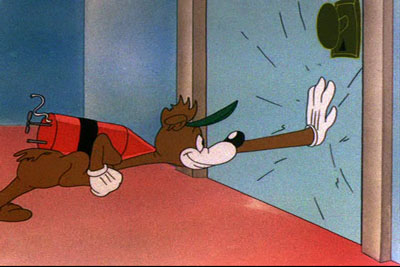 If we admire a director's cartoons, it's natural to want to believe that everything significant about them originated in that director's creative decisions. That's easier to do with some directors—Tex Avery, Chuck Jones, and Wilfred Jackson come quickly to mind—than with others, including Clampett. The online critiques of Clampett's cartoons tend to dwell on small parts of his cartoons, where what Clampett was doing was certainly intentional—and often brilliant—but many of the Clampett cartoons' most distinctive characteristics were, as I wrote in Hollywood Cartoons, essentially accidental. The same was true of other cartoons, like the early-'30s Fleischers. The difference was that Clampett permitted and even encouraged the accidents, and often shaped them to his own purposes, whereas Dave Fleischer worked on a lower level of awareness.
If we admire a director's cartoons, it's natural to want to believe that everything significant about them originated in that director's creative decisions. That's easier to do with some directors—Tex Avery, Chuck Jones, and Wilfred Jackson come quickly to mind—than with others, including Clampett. The online critiques of Clampett's cartoons tend to dwell on small parts of his cartoons, where what Clampett was doing was certainly intentional—and often brilliant—but many of the Clampett cartoons' most distinctive characteristics were, as I wrote in Hollywood Cartoons, essentially accidental. The same was true of other cartoons, like the early-'30s Fleischers. The difference was that Clampett permitted and even encouraged the accidents, and often shaped them to his own purposes, whereas Dave Fleischer worked on a lower level of awareness.
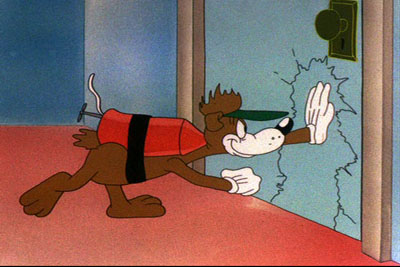 One reason Clampett didn't worry much about accidents was that they rarely got in the way of what he cared most about when he was making his cartoons. He was very much an audience-conscious director, and I remember from my conversations with him, in person and by telephone over a period of 15 years, that his opinions of his own work were governed almost entirely by what he thought his audiences had responded to. Time and again, he spoke warmly of cartoons that resist classification as his best work but that he remembered as having produced laughter in the theaters of the early '40s. Contrariwise, he didn't have a lot to say about his last and, I think, best cartoons, like Book Revue and The Great Piggy Bank Robbery, cartoons that weren't released until 1946, long after he left Warner Bros.
One reason Clampett didn't worry much about accidents was that they rarely got in the way of what he cared most about when he was making his cartoons. He was very much an audience-conscious director, and I remember from my conversations with him, in person and by telephone over a period of 15 years, that his opinions of his own work were governed almost entirely by what he thought his audiences had responded to. Time and again, he spoke warmly of cartoons that resist classification as his best work but that he remembered as having produced laughter in the theaters of the early '40s. Contrariwise, he didn't have a lot to say about his last and, I think, best cartoons, like Book Revue and The Great Piggy Bank Robbery, cartoons that weren't released until 1946, long after he left Warner Bros.
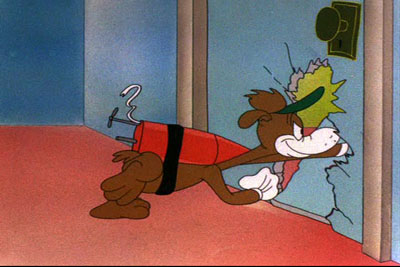 In short, Clampett didn't leave us many useful cues as to how we might respond to his work. In that respect, he was like many other artists. Groucho Marx's opinion of Duck Soup was notoriously fickle; he dismissed it at first, because it was a box-office flop, only to revise his opinion upward when scholars and critics began to rank it as the Marx Brothers' best film. In their later years Floyd Gottfredson (Mickey Mouse) and Charles Schulz (Peanuts) both resisted the idea that their comic strips had declined in quality, and Gottfredson actually insisted that his weakest work was his best. Chuck Jones rarely if ever let slip a hint that he thought his post-Warner films (not to mention his drawings and paintings) were a big step down from his best cartoons.
In short, Clampett didn't leave us many useful cues as to how we might respond to his work. In that respect, he was like many other artists. Groucho Marx's opinion of Duck Soup was notoriously fickle; he dismissed it at first, because it was a box-office flop, only to revise his opinion upward when scholars and critics began to rank it as the Marx Brothers' best film. In their later years Floyd Gottfredson (Mickey Mouse) and Charles Schulz (Peanuts) both resisted the idea that their comic strips had declined in quality, and Gottfredson actually insisted that his weakest work was his best. Chuck Jones rarely if ever let slip a hint that he thought his post-Warner films (not to mention his drawings and paintings) were a big step down from his best cartoons.
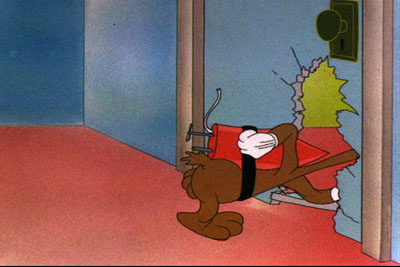 Such examples could be multiplied endlessly, from the fine arts as well as the popular arts, but, happily, what such artists thought of their work simply doesn't matter much. Every work of art, when it enters the world, takes on a life independent of what its creator thought he was doing and how well he thought he was doing it. If that weren't the case, great art of many kinds, like all the paintings and music and sculpture and architecture that grew out of conflicting religious traditions, would be inaccessible to us.
Such examples could be multiplied endlessly, from the fine arts as well as the popular arts, but, happily, what such artists thought of their work simply doesn't matter much. Every work of art, when it enters the world, takes on a life independent of what its creator thought he was doing and how well he thought he was doing it. If that weren't the case, great art of many kinds, like all the paintings and music and sculpture and architecture that grew out of conflicting religious traditions, would be inaccessible to us.
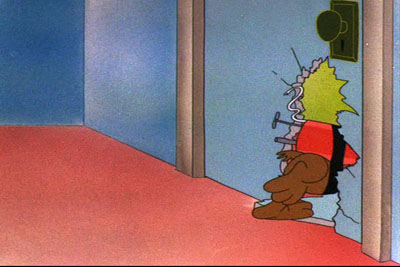 It can be liberating to admit that you don't have to be confined by what Groucho Marx or Chuck Jones or Bob Clampett thought about his work. It can also be threatening. If, as I've suggested, some of Clampett's ardent admirers are preoccupied with the details of his cartoons, and correspondingly reluctant to look at the cartoons whole, one reason may be that they can't accept the distance that thinking about a cartoon as a whole inevitably puts between us and the artist. If we're talking about a few seconds of a cartoon, it's easy to imagine ourselves at the director's elbow, thrilled by his creative decisions; if we're talking about a whole cartoon, it can be much harder to align ourselves with what the director himself thought.
It can be liberating to admit that you don't have to be confined by what Groucho Marx or Chuck Jones or Bob Clampett thought about his work. It can also be threatening. If, as I've suggested, some of Clampett's ardent admirers are preoccupied with the details of his cartoons, and correspondingly reluctant to look at the cartoons whole, one reason may be that they can't accept the distance that thinking about a cartoon as a whole inevitably puts between us and the artist. If we're talking about a few seconds of a cartoon, it's easy to imagine ourselves at the director's elbow, thrilled by his creative decisions; if we're talking about a whole cartoon, it can be much harder to align ourselves with what the director himself thought.
But for the devoted Clampett fan, as for devoted fans of other kinds, there's a way out. I heard this recently from one of the Clampett partisans:
Clampett's intuitive approach went beyond the energy sketches [which are described in Hollywood Cartoons]. It also had to do with his choice of material, his love of life, his focus on charisma, star quality and "magic", his sense of rhythm and fun, his ability to enthuse other people, his taste, his culture, his love of cartooning (including print cartooning), animation, acting, theater, radio, film and music, his extension of musical practice into areas that weren't previously thought of that way, his love for the work of other creative people and his enthusiastic acceptance of their different styles, his competitiveness, and his passion.
When a director's "approach" is defined in such sweeping terms, almost everything he did can be acclaimed a dazzling success (the rare exceptions can be blamed on someone else's failure to live up to the artist's vision). The complexities that make his films interesting can be flattened in the name of celebrating his art. The director himself, hailed as an implausible demigod, can be transformed into an obstacle between us and his creations. It won't be enough to talk about his cartoons solely in positive terms; the positive terms must be of a kind that foreclose the validity of any skeptical response, however limited, and so of any meaningful discussion.
Such is the kind of damage that hero worship always does. I'm afraid that today it is the kind of damage that some of Bob Clampett's most dedicated admirers are inflicting on him and his endlessly fascinating and often wonderful cartoons.
[Posted March 3, 2008]